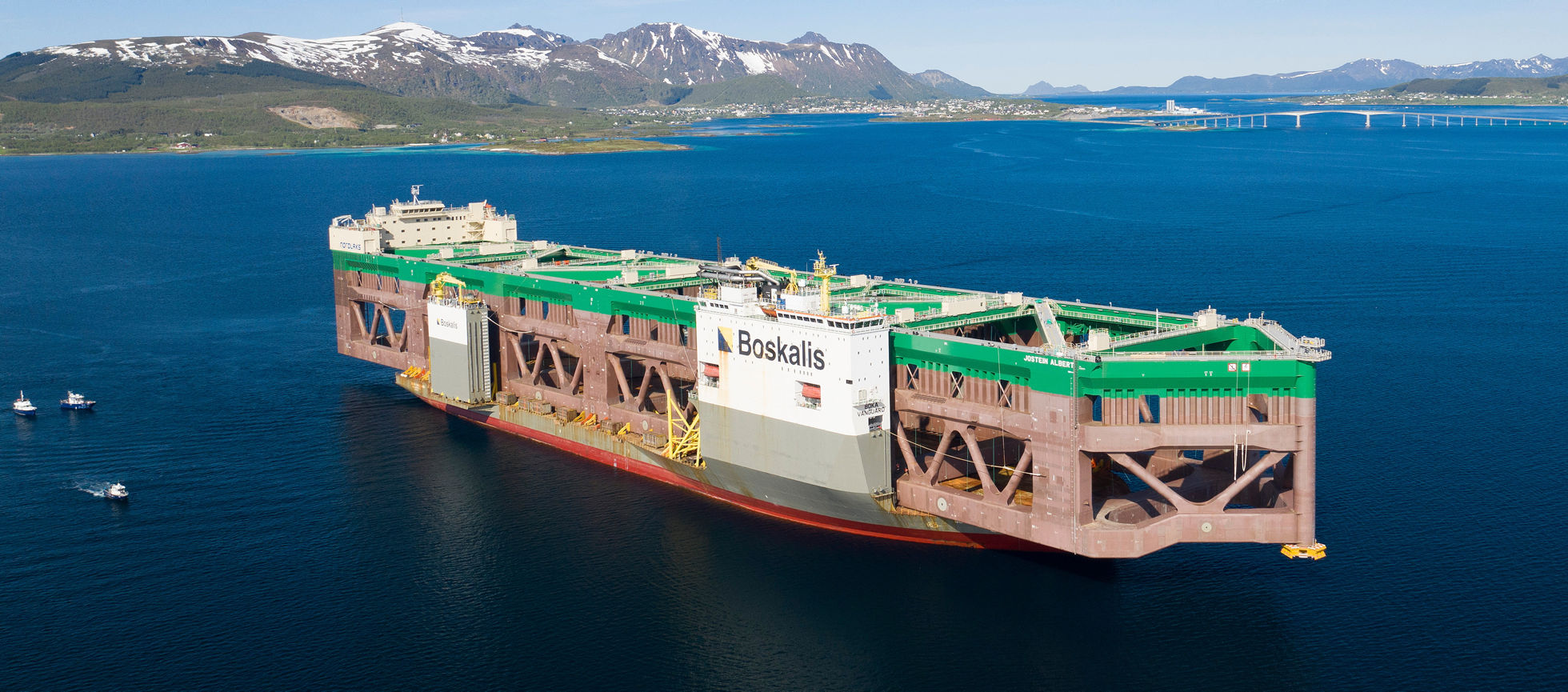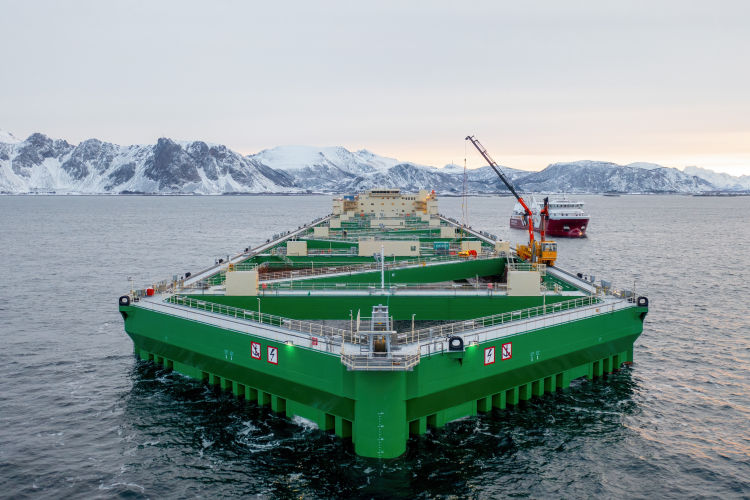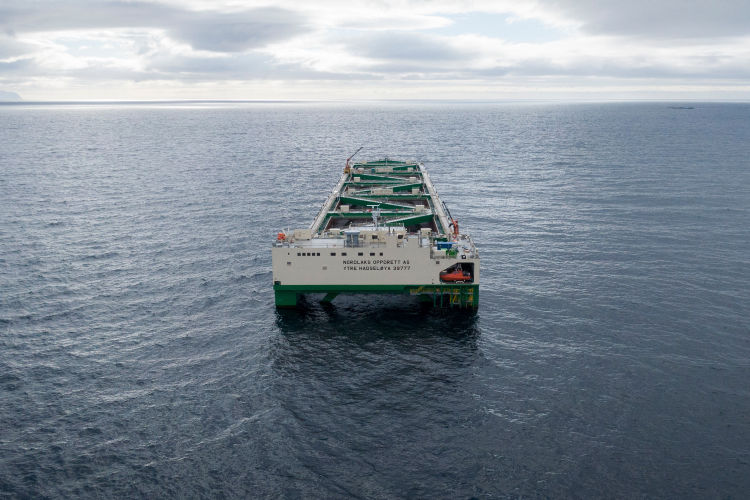The Ocean Farm Jostein Albert

The Ocean Farm “Jostein Albert” is located on the site Ytre Hadseløy in Hadsel municipality in Nordland. The location is approximately 5 kilometers from land and is the most exposed location for farming that is in operation in Norway today.
“Jostein Albert” is the result of a large innovation and development project that Nordlaks started in early 2015, when the authorities were preparing a new scheme to stimulate technological development in the aquaculture industry. Nordlaks was the first company to submit an application for development permits, and one of the first companies to realize and carry out the development project.
The Ocean Farm “Jostein Albert” is operated today as a regular part of the site structure of Nordlaks Oppdrett AS, with an overarching plan for annual stocking of salmon. Due to the short production time, it is possible to carry out set-aside, production and fallowing in advance of a new set-aside, within a year. As of summer 2022, the third operating cycle is underway in “Jostein Albert”.
Background for the project
Development and construction of the Ocean Farm “Jostein Albert” would not have been possible without the Norwegian authorities’ scheme for development permits. The scheme, which was established in 2015 and discontinued in 2017, was supposed to stimulate innovation and the development of technology to help solve land and environmental challenges in the aquaculture industry.
The basic idea behind the Ocean Farm project is that the area challenge in the aquaculture industry is closely linked to environmental and other challenges such as fish health and welfare. For us it was, and still is, completely obvious that the aquaculture industry needs access to sea area in order to develop further. The Ocean Farm represents the development of new technology that enables the use of new areas along the Norwegian coast for aquaculture and food production. The ability to use new land also provides room for spreading the production of fish in time and space. There are crucial prerequisites for controlling salmon lice through prevention and thus reducing the environmental impact of our industry.
The Ocean Farm “Jostein Albert” is among the absolute foremost projects in the world to contribute to the development of a more exposed and eventually ocean-going (offshore) aquaculture industry.
Knowledge sharing from the project
The granting of development permits for stationary ocean farms sets the criteria of sharing knowledge from the project. In order to meet these criteria, Nordlaks shares experiences, new knowledge and data from the ocean farm project in various ways. Some of the knowledge sharing takes place via publications that are available here.
Location and monitoring of the environment
The authorities have granted a location permit for the Ocean Farm on Ytre Hadseløya (loc no. 39777), south-west of Hadseløya in Hadsel municipality in Vesterålen. Permission has been granted for 10,000 tonnes of MTB on the site, with a time limit until 31st of December 2025.
Prior to the start of operations at the site, Nordlaks has carried out many surveys to document the zero state (state of nature) for the environment at the bottom in the construction zone and around the facility (transition zone).
While the sea farm is in operation, an adapted and extended environmental monitoring program is carried out to document whether and to what extent the operation affects the environment below and around the facility. If the results of the environmental monitoring show that it is justifiable, Nordlaks can apply for a permanent permit for 10,000 tonnes of MTB.
The results from the monitoring program have been very good in the first two years of operation in the Ocean Farm. The environmental condition has been reduced from 1 (very good, i.e. best grade) to 2 (good) during the two exposures. We have documented both of the times that the environmental condition has improved during the operation, from halfway through production until just before slaughter. These are unusual and good results, as the greatest stress on the seabed usually occurs in the last period before the slaughter when the fish are at their largest size. During the set-aside period, we have documented a further improvement, so that the environmental condition ahead of each of the three exposures has been 1 (very good). It has so far been documented that the environment is restored between each production cycle. The fact that the environmental condition at the bottom is maintained over time is sustainability in practice.
The results from the monitoring program are public and can be downloaded from the Directorate of Fisheries’ website. The most recent report was carried out in March 2022 and can be downloaded here.
Barentswatch also publishes the results of weekly lice counts as well as information on well boat calls etc. at the locality.
Technical data and dimensions
- Length: 385 meter
- Width: 59,5 meter
- Depth: 37,75 meter
- Not: 6 units á 69 000 m3. Each not is up to 56 meters deep.
- Energy sources: Clean energy from land. Backup generators in case of power outage.
The Ocean Farm “Jostein Albert” is 385 meters long, 59.5 meters wide and has a capacity of 10,000 tonnes of salmon. The Ocean Farm is located 5 kilometers south-west of Hadseløya in Hadsel municipality in Vesterålen. The facility has an anchoring solution in the bow section and will be firmly anchored on a slope around the site’s center point. The facility’s direction and thus location within the locality is determined by wind, wave and current direction.
The Ocean Farm is moored with 11 anchors, each weighing 22 tonnes. Each anchor has a holding power of between 300 and 450 tonnes. The anchors are deployed in three groups, with four anchors per group to the north-west and south-west and a group of three anchors to the east. It is approximately 650 meters from the anchors to the site’s center point. The sea farm itself moves within a circle with a radius of 450 meters from the site’s center point.
In accordance with the Norwegian Coastal Administration’s regulations, Havfarmen is labeled as a farming facility. This includes, among other things, flashing lights on the outer edges of the facilities.


Ripple effects from the Ocean Farm project
The Havfarm project creates major ripple effects, particularly in northern Norway. With 13 new permits for aquaculture, Nordlaks has the ability to increase production significantly. This has resulted in the need for the construction of new hatcheries, well boats, expansion of factories for slaughterhouses and further processing, farming and service boats as well as technical equipment for the sea farm itself. In total, Nordlaks invests over NOK 5 billion in the Ocean Farms and in other innovations along our entire value chain. This is the biggest investment in the company's history, and among the biggest industrial investments in the mainland economy in Northern Norway ever. The Havfarm project contributes to the creation of new jobs and already increases significant ripple effects from Nordlaks' activity. From 2018 until 2022, the number of employees in Nordlaks has grown from around 500 to over 700.
The Ocean Farm was built in China, but is a Norwegian-developed concept. Of the suppliers in the project, there is a preponderance of Norwegian companies. The Norwegian supplier industry is a world leader in both maritime and aquaculture technical solutions, and the Ocean Farm project contributes to bringing these environments together to develop new solutions at the interface between the maritime industry and the aquaculture industry.
The Havfarm project creates major ripple effects, particularly in northern Norway. With 13 new permits for aquaculture, Nordlaks has the ability to increase production significantly. This has resulted in the need for the construction of new hatcheries, well boats, expansion of factories for slaughterhouses and further processing, farming and service boats as well as technical equipment for the sea farm itself. In total, Nordlaks invests over NOK 5 billion in the Ocean Farms and in other innovations along our entire value chain. This is the biggest investment in the company's history, and among the biggest industrial investments in the mainland economy in Northern Norway ever. The Havfarm project contributes to the creation of new jobs and already increases significant ripple effects from Nordlaks' activity. From 2018 until 2022, the number of employees in Nordlaks has grown from around 500 to over 700.
The Havfarm project creates major ripple effects, particularly in northern Norway. With 13 new permits for aquaculture, Nordlaks has the ability to increase production significantly. This has resulted in the need for the construction of new hatcheries, well boats, expansion of factories for slaughterhouses and further processing, farming and service boats as well as technical equipment for the sea farm itself. In total, Nordlaks invests over NOK 5 billion in the Ocean Farms and in other innovations along our entire value chain. This is the biggest investment in the company’s history, and among the biggest industrial investments in the mainland economy in Northern Norway ever. The Havfarm project contributes to the creation of new jobs and already increases significant ripple effects from Nordlaks’ activity. From 2018 until 2022, the number of employees in Nordlaks has grown from around 500 to over 700.
The Ocean Farm was built in China, but is a Norwegian-developed concept. Of the suppliers in the project, there is a preponderance of Norwegian companies. The Norwegian supplier industry is a world leader in both maritime and aquaculture technical solutions, and the Ocean Farm project contributes to bringing these environments together to develop new solutions at the interface between the maritime industry and the aquaculture industry.
Suppliers
Maritimt/offshore
-
Yantai CIMC Raffles Offshore Ltd (Shipyard)
-
Boskalis (Transport of the Ocean Farm from China)
-
Siem Offshore (Laying out of mooring, float-off og hook-up)
-
DOF (Float-off og Hook-up)
-
Boa (Float-off og hook-up)
-
Seaworks (layout of shore power cable)
-
Seasystems (former- Scana) – turret, mooring and shore power cable, incl. coordination of deployment/float-off/hook-up
-
Nexans (cabel – through Scana)
-
Vryhof (Anchor – through Scana)
-
Ramnäs (Chain – through Scana)
-
SAP (Hull monitoring)
-
Kongsberg (Sensorikk til skrogovervåking)
-
Siemens (Kraft- og automasjonspakke)
-
Scanmatic (Sensorer til kjettingovervåking – gjennom Scana)
-
Techano (RMSU og dekkskran)
-
7Waves (Strukturdesign – gjennom NSK)
-
First Ocean Associates (Koordinering/ledelse av utlegging av fortøyning – gjennom Scana)
-
Semar (Koordinering/ledelse av float-off og hook-up operasjon – gjennom Scana)
-
Core Marine (Koordinering/ledelse av kabelutlegging – gjennom Scana)
-
DNV GL (Verifikasjon/klasse)
-
Servi (Notvinsjer – gjennom Selstad)
-
Jotun (maling)
-
Rolls Royce (Tunnelthrustere. Nå Kongsberg)
-
Skuld (forsikring)
-
Fearnleys/MIL Shipping (megler)
-
Premas (vedlikeholdssystem)
Havbruk
-
Akva Group (Fôringsanlegg)
-
Selstad (nøter og nothåndtering)
-
Optimar (dødfiskanlegg)
-
Lift-up (dødfiskopptak – gjennom Optimar)
-
Berg Elektro (Bistand til ferdigstilling)
-
Lofoten Elektro (Bistand til ferdigstilling)
-
Skarvik (Bistand til ferdigstilling)
-
Skretting (Fôr, og solbriller.)
-
Åkerblå (Fiskehelsetjenester)
-
Akvaplan-niva (Miljøtjenester)
-
Skarsvaag (Skyssbåt)
-
Sintef Ocean (modellforsøk)
-
Hordafôr (ensilasje/beredskap)
-
Ocein (Notvasker)
-
Blueye (Inspeksjons-ROV)
-
Pump Supply (Pumpepakke til notvasker)
-
Multiconsult (Designbidrag innenfor flere felt – gjennom NSK)
-
Fugro Oceanor (Leverandør av bølgebøye – gjennom Akvaplan-niva)
-
NSK Ship Design (Design)
-
Aanderaa/Xylem (Oksygenmålere)
-
SAIV (CTDO-sonde)
-
SJ Dykk (Dykkertjenester ifm utlegging av kabel)
-
Dykkerkompaniet (Dykkertjenester ifm. ferdigstillelse)
-
Veterinærinstituttet (Faglig ansvar for dokumentasjonsprogram – biologisk prestasjon)
Øvrige leverandører
-
Allweiler (pumper)
-
Brødrene Dahl (ventiler)
-
Jets (Sanitærsystem inkl. kloakkbehandlingssystem)
-
Viking Norsafe (Redningsutstyr og Fast Daughter Craft)
-
IMS (Vanntette skyvedører)